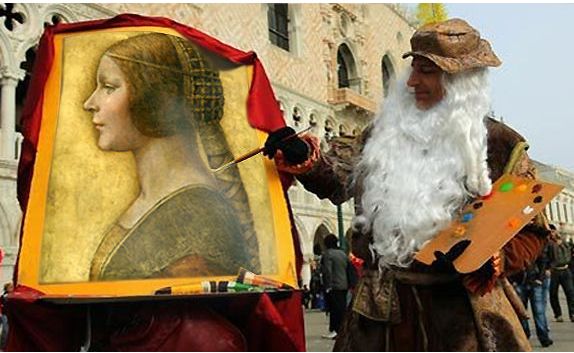The ones in the profile are very delicate.
這幅側(cè)面畫里的線條都很纖細
Leonardo tended to caress these profiles and he keeps them alive,
達芬奇會擦一下線條,但沒有把它們擦沒了
many artists if they go over a profile
很多畫家如果擦那些線條
twice or three times it dies.
兩三次,就會把它們擦沒了

Leonardo manages to keep that extraordinary vitality of line
達芬奇設法保持住了線條的活力
even when he's caressing it three or four times
雖然他擦了它們有三四次
to make it the shape he wants.
擦出他想要的形狀
But then there are bigger pentimenti.
但還有一個更大的修改筆畫
There are ones particularly in the hair,
尤其是頭發(fā)那里的筆畫
the hairstyle call her cap at the back,
她的發(fā)式后面戴著的那個叫小帽的東西
originally it was much bigger and much fatter
原本是很大很膨脹的
so there are some quite dramatic pentimenti
所以有一些很大的修改筆畫
and we can see the one at the back of her head
我們可以看到她頭部后面那個
that Leonardo has used a kind of rubber.
達芬奇用一些類似橡膠的東西
Probably bread crumbs gathered together to take out something
很可能是抓起一把面包屑,在上色之前
that was drawn in chalk before it was inked in.
把原本用粉筆畫的東西擦掉
Yeah so there's a series of pentimenti.
是的,上面有很多修改的筆畫
The technical analysis also threw up a lot of other things.
技術(shù)分析還發(fā)現(xiàn)了很多東西
One of the things it threw up was a fingerprint.
其中一樣是一個指紋
It also showed under the surface,
也是在畫的表面下的
there's been quite a lot of surface restoration,
因為畫的表面做過很多修復
that Leonardo,or the artist lets say,
達芬奇,或者說那個畫家
had used that bit of his hand to blend the pigments.
用他的手把干粉顏料混合起來
We've been doing a lot of technical analysis of Leonardo's
我們對達芬奇的畫做過很多分析
and most pictures,it seems a little bit in the Mona Lisa,
大部分的畫...在蒙娜麗莎上面也有一點
but most of the earlier pictures
他早期大部分的畫
he used his hands and fingers a lot.
都經(jīng)常用他的手和手指
So when he was wishing to blend something
所以當他想混合顏料時
he would sometimes use his fingers particularly
他有時會有他的手指
he used that bit of his hand and it's always the right hand
尤其是有時他會用手,而且總是右手
as far as we can tell because he's a left hander.
因為據(jù)我們所知,他是一個左撇子
So he's putting some,
他放了一點...
if you can imagine some pastels in and he wants to blend them
你們可以想像一下,他放了一些干粉顏料,他想混合它們
so he just gives them a little caress with that bit of his hand.
所以他用他的手揉了一下
And under the restoration,
在修復下面...
this is something that a forger wouldn't do
贗造者是不會做這一步的
because they wouldn't necessarily know about that
因為他們并不一定會知道有這一步
as it's fairly new knowledge,
這是我們最近才發(fā)現(xiàn)的
we found evidence of his handprint technique being used.
我們發(fā)現(xiàn)有證據(jù)表明他用了打手印的方法
In the left margin we found the tip of a fingerprint.
在左邊緣的地方我們找到了一點末端的指紋
It's not like you imagine if you were Sherlock Holmes,
不是你們平常看福爾摩斯的那樣
you haven't got a great big pad with a whirl in the middle
有一大個指紋,中間還有一個旋渦
but we've got that little top bit of the finger.
但我們找到了手指末端的一點指紋
And this I got Paul Beuro in Montreal
我找到了蒙特里爾的Paul Beuro
who is a world expert in fingerprints in paintings.
他是繪畫指紋的世界專家
He looked at that,fingerprints are highly technical.
他看了這個指紋,辨別指紋需要高度專業(yè)的知識
What you and I can see is not very much basically
我們看到那段指紋覺得不是什么了不起的證據(jù)
because we don't know what we're looking for.
因為我們不知道怎么辨別
Anyway he looked at that
總之他看了那段指紋
and said there's a very characteristic pattern there,
他說指紋有一個很有特色的紋路
we've got a little longitudinal island amongst that
我們發(fā)現(xiàn)指紋上有一個縱向紋島
which relates to other bits of the fingerprint.
這跟指紋其他部分相連
And he said "Are there other Leonardo fingerprints?"
他說"你們還有別的達芬奇的指紋嗎?"
and I said "Leonardo paintings are full of fingerprints!"
我說"達芬奇的畫上滿是指紋"
which we were increasingly realising.
這是我們越來越肯定的











